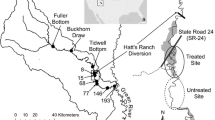Abstract
The planned Narrows Reservoir on the South Platte River in Colorado is expected to jeopardize the maintenance of scarce instream waterfowl habitat 400 km downstream in Nebraska's Big Bend reach of the mainstem Platte River. Extreme shrinkage of wide, shallow channel habitat for sandhill and endangered whooping cranes in the Central Flyway has resulted from past reservoir development along the North and South Platte Rivers in Wyoming and Colorado. Proposals to counteract further shrinkage caused by streamflow regulation and depletion include controlled annual peak flows designed to scour the banks, sandbars, and emerging vegetation. The criteria for effective channel maintenance by streambed scouring are examined, as well as the principles involved. The feasibility of preserving the remaining habitat by releasing scouring flows from the Narrows Dam is found seriously lacking. Alternative mechanical measures, such as dredging the channel and bulldozing the tree cover, may prove more practical, although possibly unaffordable.
Similar content being viewed by others
References
Boudreaux, J., 1982, Special report to Ecological Services, Region 6, Fish and Wildlife Service, on review and analysis of Platte River studies, Blatchley Assoc., Denver, CO, unpublished.
Bureau of Reclamation, 1982a, Water Use and Management in the Upper Platte River Basin, U.S. Bur. Rec., Lower Missouri Reg., Denver, CO.
Bureau of Reclamation, 1982b, Potential Effects of the Narrows Project on the Platte River Migratory Habitat of the Endangered Whooping Crane, U.S. Bur. Rec., Lower Missouri Reg., Denver, CO.
Bureau of Reclamation, 1985, Final Supplement to the Final Environmental Statement, Narrows Unit, Pick-Sloan Missouri Basin Program, Colorado, U.S. Bur. Rec., Lower Missouri Reg., Denver, CO.
Currier, P., Lingle, G., and Vanderwalker, J., 1985, Draft report on migratory bird habitat on the Platte and North Platte Rivers in Nebraska, Platte River Whooping Crane Habitat Maintenance Trust, Grand Island, NE, unpublished.
Colby, B., 1957, Relationship of unmeasured sediment discharge to mean velocity, Trans. Amer. Geophys. U. 38.
Colby, B. and Hembree, C., 1955, Computations of total sediment discharge, Niobrara River near Cody, Nebraska, U.S. Geol. Surv. Water Supp. Paper 1357.
Department of the Interior, 1983, Upper Platte River Study: Ecological Studies; Water Use and Management; Flow Conditions and Channel Morphology, U.S. Bur. Rec., U.S. Fish Wild. Serv., and U.S. Geol. Surv., Denver, CO.
Ellis, S., Shoemaker, T., Shen, H., and Wang, W., 1981, Niobrara River Whooping Crane Habitat Study, U.S. Bur. Rec., Lower Missouri Reg., Denver, CO.
Eschner, T., 1983, Hydraulic geometry of the Platte River near Overton, south-central Nebraska, U.S. Geol. Surv. Prof. Paper 1277-C.
Eschner, T., Hadley, R., and Crowley, K., 1983, Hydrologic and morphologic changes in channels of the Platte River Basin in Colorado, Wyoming and Nebraska: A historical perspective, U.S. Geol. Surv. Prof. Paper 1277-A.
Fish and Wildlife Service, 1981, The Platte River Ecology Study N. Prairie Wild. Res. Cen., Jamestown, ND.
Fish and Wildlife Service, 1983, Narrows Unit Biological Opinion: Whooping Crane, U.S. Fish Wild, Serv., Reg. 6, Lakewood, CO.
Fish and Wildlife Service, 1985, Evaluation Framework Planning Aid Report for the Prairie Bend Unit, Nebraska, Grand Island, NE.
Karlinger, M., Mengis, R., Kircher, J., and Eschner, T., 1981, Application of theoretical equations to estimate the discharge needed to maintain channel width in a reach of the Platte River near Lexington, Nebraska, U.S. Geol. Surv. Open File Rep. 81-697.
Kircher, J., 1981, Sediment transport and effective discharge of the North Platte, South Platte and Platte Rivers in Nebraska, U. S. Geol. Surv. Open File Rep. 81-53.
Kircher, J. and Karlinger, M., 1983, Effects of water development on surface water hydrology, Platte River Basin in Colorado, Wyoming and Nebraska upstream from Duncan, Nebraska, U.S. Geol. Surv. Prof. Paper 1277-B.
Nebraska Game and Parks Commission, 1985, Report of Biological Opinion, Little Blue-Catherland Project, to Water Resources Department, Nebr. Game Parks Comm., Lincoln, NE.
Parker, G., 1978, Self-formed rivers with stable banks and mobile bed: Part I, The sand-silt river; Part 2, The gravel river, J. Fluid Mech. 89, 109–125, 127–147.
Pitts, T., 1985, Memorandum to Platte River Technical Steering Committee on proposed revisions to the draft work plan, Tom Pitts Assoc., Loveland, CO, unpublished.
Williams, G. P., 1978, The case of the shrinking channels: The North Platte and Platte Rivers in Nebraska, U.S. Geol. Surv. Circ. 781.
Williams, G. P. and M. G. Wolman, 1984, Downstream effects of dams on alluvial rivers, U.S. Geol. Surv. Prof. Paper 1286.
Author information
Authors and Affiliations
Rights and permissions
About this article
Cite this article
Nelson, R.W., Dwyer, J.R. & Greenberg, W.E. Regulated scouring in a sand-bed river for channel habitat maintenance: A Platte River waterfowl case study. Water Resour Manage 2, 191–208 (1988). https://doi.org/10.1007/BF00429901
Received:
Revised:
Issue Date:
DOI: https://doi.org/10.1007/BF00429901




